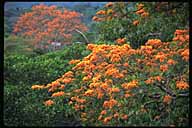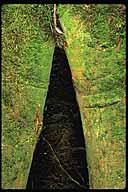Flora
by
Christopher Baker
Home : Travel : Costa Rica : CR Handbook : One Article
 Costa Rica has an extraordinary abundance of flora, including some
9,000-plus species of "higher plants." There are many more species of ferns in
Costa Rica--about 800--than in the whole of North America, including Mexico. Of
heliconias, members of the banana family more familiarly known as "birds of
paradise," there are some 30 species. It is a nation of green upon green upon
green.
Costa Rica has an extraordinary abundance of flora, including some
9,000-plus species of "higher plants." There are many more species of ferns in
Costa Rica--about 800--than in the whole of North America, including Mexico. Of
heliconias, members of the banana family more familiarly known as "birds of
paradise," there are some 30 species. It is a nation of green upon green upon
green.
 The forests and grasslands flare with color, some flamboyantly so,
for plants like to advertise the delights and rewards they have to offer,
including the ultimate bribe--nectar. Begonias, anthuriums, and blood of
Christ, named for the red splotches on the underside of its leaves, are common.
My favorite plant is the "hot lips" (labios ardientes), sometimes called
"hooker's lips" (labios de puta), whose bright red bracts remind me of
Mick Jagger's famous pout or--more appropriately--Madonna's smile. The
vermilion poró tree (the bright flame-of-the-forest),
pink-and-white meadow oak, purple jacaranda, and the almost fluorescent yellow
corteza amarilla are trees that all add their seasonal bouquets to the
landscape. And morning glory spread their thick lavender carpets across lowland
pastures, joined by carnal red passion flowers, unromantically foul-smelling--a
crafty device to enlist the help of flies in pollination.
The forests and grasslands flare with color, some flamboyantly so,
for plants like to advertise the delights and rewards they have to offer,
including the ultimate bribe--nectar. Begonias, anthuriums, and blood of
Christ, named for the red splotches on the underside of its leaves, are common.
My favorite plant is the "hot lips" (labios ardientes), sometimes called
"hooker's lips" (labios de puta), whose bright red bracts remind me of
Mick Jagger's famous pout or--more appropriately--Madonna's smile. The
vermilion poró tree (the bright flame-of-the-forest),
pink-and-white meadow oak, purple jacaranda, and the almost fluorescent yellow
corteza amarilla are trees that all add their seasonal bouquets to the
landscape. And morning glory spread their thick lavender carpets across lowland
pastures, joined by carnal red passion flowers, unromantically foul-smelling--a
crafty device to enlist the help of flies in pollination.
Many plants play out the game of love and reproduction in the heat
of the tropical night, when they emit their irresistible fragrances designed to
attract specific insect species. Other flowering species employ markings on
their petals to indicate the exact placing of the rewards insects seek. Many
orchid species, for example, are marked with lines and spots like an airfield,
to show the insect where to land and in which direction to taxi (see "Orchids,"
below). Others display colors invisible to the human eye, yet clearly
perceptible by insects whose eyesight spans the ultraviolet spectrum.
 The most abundant flora in rainforest environments are ferns,
light-gap pioneers found from sea level to the highest elevations. The ancient
terrestrial ferns once served as food for many a prehistoric beast. The big
tree ferns--sometimes called rabo de mico ("monkey-tail") ferns, an
allusion to the uncurling young fronds--are relics from the age of the
dinosaurs, sometimes a dozen feet tall, with fiddleheads large enough to grace
a cello. Others are epiphytic, arboreal "nesters," or climbers whose long
leaves can grapple upward for 60 feet or more.
The most abundant flora in rainforest environments are ferns,
light-gap pioneers found from sea level to the highest elevations. The ancient
terrestrial ferns once served as food for many a prehistoric beast. The big
tree ferns--sometimes called rabo de mico ("monkey-tail") ferns, an
allusion to the uncurling young fronds--are relics from the age of the
dinosaurs, sometimes a dozen feet tall, with fiddleheads large enough to grace
a cello. Others are epiphytic, arboreal "nesters," or climbers whose long
leaves can grapple upward for 60 feet or more.
 The epiphytic environment (epiphyte comes from the Greek, "upon
plants") is extremely poor in mineral nutrients, a kind of nutrient desert. The
bromeliads, brilliantly flowering, spiky-leafed "air" plants up to four feet
across, have developed tanks or cisterns which hold great quantities of
rainwater and decaying detritus in the whorled bases of their tightly
overlapping stiff leaves. The plants gain nourishment from dissolved nutrients
in the cisterns. Known as "tank epiphytes," they provide trysting places and
homes for tiny aquatic animals high above the ground. Costa Rica has over 2,000
species of bromeliads (including the pineapple), the richest deposit of such
flora on the isthmus.
The epiphytic environment (epiphyte comes from the Greek, "upon
plants") is extremely poor in mineral nutrients, a kind of nutrient desert. The
bromeliads, brilliantly flowering, spiky-leafed "air" plants up to four feet
across, have developed tanks or cisterns which hold great quantities of
rainwater and decaying detritus in the whorled bases of their tightly
overlapping stiff leaves. The plants gain nourishment from dissolved nutrients
in the cisterns. Known as "tank epiphytes," they provide trysting places and
homes for tiny aquatic animals high above the ground. Costa Rica has over 2,000
species of bromeliads (including the pineapple), the richest deposit of such
flora on the isthmus.
All plants depend on light to power the chemical process by which
they synthesize their body substances from simple elements. Height is therefore
of the utmost importance. When an old tree falls, the strong, unaccustomed
light triggers seeds that have lain dormant, and banana palms and ginger
plants, heliconias and cecropias--all plants that live in the sunshine on
riverbanks or in forest clearings--burst into life and put out big broad leaves
to soak up the sun, to flower and to fruit. Another prominent plant is the poor
man's umbrella (sombrilla de pobre), whose name you'll remember if you
get caught in a downpour while in the rainforest; its giant leaves make
excellent impromptu umbrellas.
philg@mit.edu
 The forests and grasslands flare with color, some flamboyantly so,
for plants like to advertise the delights and rewards they have to offer,
including the ultimate bribe--nectar. Begonias, anthuriums, and blood of
Christ, named for the red splotches on the underside of its leaves, are common.
My favorite plant is the "hot lips" (labios ardientes), sometimes called
"hooker's lips" (labios de puta), whose bright red bracts remind me of
Mick Jagger's famous pout or--more appropriately--Madonna's smile. The
vermilion poró tree (the bright flame-of-the-forest),
pink-and-white meadow oak, purple jacaranda, and the almost fluorescent yellow
corteza amarilla are trees that all add their seasonal bouquets to the
landscape. And morning glory spread their thick lavender carpets across lowland
pastures, joined by carnal red passion flowers, unromantically foul-smelling--a
crafty device to enlist the help of flies in pollination.
The forests and grasslands flare with color, some flamboyantly so,
for plants like to advertise the delights and rewards they have to offer,
including the ultimate bribe--nectar. Begonias, anthuriums, and blood of
Christ, named for the red splotches on the underside of its leaves, are common.
My favorite plant is the "hot lips" (labios ardientes), sometimes called
"hooker's lips" (labios de puta), whose bright red bracts remind me of
Mick Jagger's famous pout or--more appropriately--Madonna's smile. The
vermilion poró tree (the bright flame-of-the-forest),
pink-and-white meadow oak, purple jacaranda, and the almost fluorescent yellow
corteza amarilla are trees that all add their seasonal bouquets to the
landscape. And morning glory spread their thick lavender carpets across lowland
pastures, joined by carnal red passion flowers, unromantically foul-smelling--a
crafty device to enlist the help of flies in pollination. Costa Rica has an extraordinary abundance of flora, including some
9,000-plus species of "higher plants." There are many more species of ferns in
Costa Rica--about 800--than in the whole of North America, including Mexico. Of
heliconias, members of the banana family more familiarly known as "birds of
paradise," there are some 30 species. It is a nation of green upon green upon
green.
Costa Rica has an extraordinary abundance of flora, including some
9,000-plus species of "higher plants." There are many more species of ferns in
Costa Rica--about 800--than in the whole of North America, including Mexico. Of
heliconias, members of the banana family more familiarly known as "birds of
paradise," there are some 30 species. It is a nation of green upon green upon
green.
